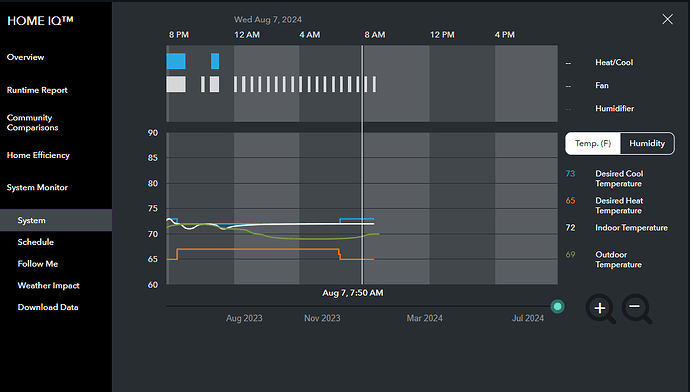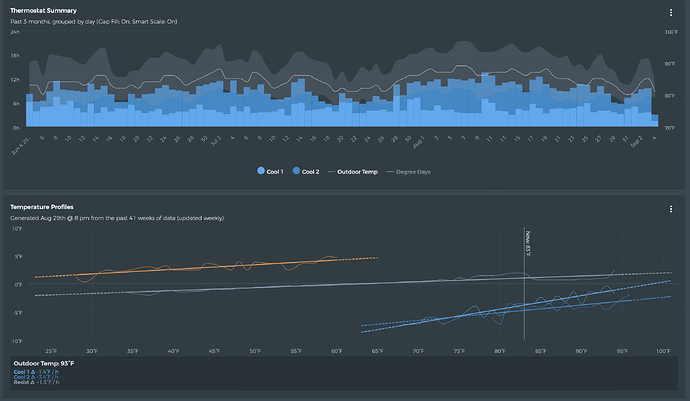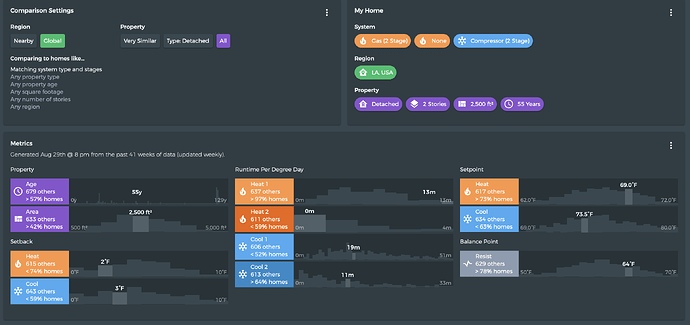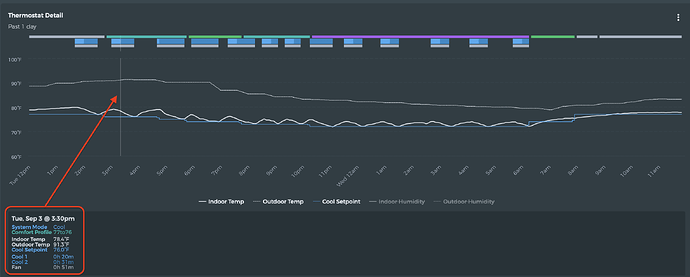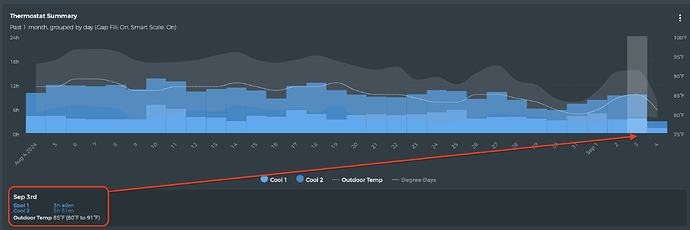Minimize costs by a) DIY. The wiring shouldn't be too hard (manuals + YouTube + existing wiring). Hardest part could be just pulling a new wire, b) scheduling upgrade during a seasonal service to eliminate a truck roll, c) look for electricity/gas company rebates. Owning a home is expensive. If you're not spending money annually you are just adding to deferred maintenance.
I’m not an Ecobee user so I can’t say for sure, but keep in mind that the local HomeKit compatibility doesn’t mean you can replicate everything that’s possible in the Ecobee app (and requires cloud connectivity).
I would guess that looking at historical trends (which you’ve mentioned is important to you) is one example of that.
Oh yea, I anticipated that, but thanks for mentioning it. But from what others have said I should be able to keep everything else I want to be able to do like remotely control the thermostat from a mobile device, PC, and Alexa. In the event they decide to do something similar and decommission my new Ecobee then at least I can keep those services for a while. By then I may be willing to let go of historical reporting. Thanks.
My A/C Company doesn't operate like that. They basically put you on a yearly subscription that buys you the response time. If you don't buy a subscription you are basically subject to their first availability. My subscription (their top tier plan) has them here pretty much immediately for any service I want, 365, 24x7. The top tier plan also pays for all my annual maintenance, which they pretty much do twice per year for the A/C, furnace, condenser, air handler, etc.. Then they charge ala carte for each service. I know they are going to have one charge for rewiring a thermostat like this. No idea what it might be yet.
I did find a rebate through my gas company for Ecobee. Oddly, I save more (only $5) doing that than using their discount code for gen 1 Ecobee users. Go figure.
I know people might think my own thinking is off, but I throw money at certain things and there are certain things I don't. I mow my own lawn, hand wash my cars, etc.. But my A/C is something I don't venture in to tinkering with on my own. I'll research and give them guidance, but that's about it. I fully rebuilt the HVAC system when we moved into the house we are in now and it was one of the best decisions I made. Moved all the equipment to better locations, put return ducts in every bedroom, supported a start-up company called Ecobee (![]() ) for a new smart thermostat, etc.. So, when it comes to wiring, it is probably better I put it in their hands. That is one of those projects that will take the average person an hour to do, but me 3 days with intermittent A/C outages.
) for a new smart thermostat, etc.. So, when it comes to wiring, it is probably better I put it in their hands. That is one of those projects that will take the average person an hour to do, but me 3 days with intermittent A/C outages. ![]()
Bear in mind that the ecobee3 Lite doesn't support HVAC accessories. So no humidifier/dehumidifier/ERV/HRV etc. Accessories are supported in the ecobee Smart Thermostat Premium and Smart Thermostat Enhanced. They are also supported by the ecobee3 (not 3 Lite), and ecobee4.
Correct. All current ecobee models support HomeKit.
@aaiyar, you are the gift that keeps giving. Thank you again. I don't believe I have any of these accessories now, but its worth the little extra money just have it in case I ever need any of this. I always wanted a whole-house dehumidifier, but never could pull the trigger. I was worried it would just be one more thing to maintain, but having that kind of control has always been a "want." Who knows, one day maybe.
I've spent more time futzing with thermostats of all manner than I care to admit.
I will say this much in favor of ecobee. I had removed my ecobee3 thermostat in my old house because I felt I could do better with a locally-controlled thermostat and zigbee/z-wave temperature/humidity sensors. It took me almost 2 years to find a z-wave thermostat that worked with a 4H/2C system. And then at least a year finessing a flow in Node-RED to achieve the degree of comfort that the ecobee3 provided. Just before I put that house up for sale, I removed the z-wave thermostat and put an ecobee thermostat back on. It was a humbling experience to see how it "just worked" with no mucking about.
That experience, along with advice from @ogiewon, convinced me that I don't want to automate comfort to the extent I had automated previously. Homes should be comfortable without needing a complicated set of programs controlling the thermostat. While I do have 2 sensors with my current ecobee, I primarily used them to balance the upstairs & downstairs in my house. It is as closely balanced as it will ever get now - so I don't really need those sensors anymore to maintain comfort (although I like pretty graphs and data, so they'll stay in operation).
Apart from scheduling with comfort profiles, the only automation I do with my ecobee now is geofencing. I have used the app to control the thermostat maybe once in the last month. And I've touched the thermostat maybe once in the last 2 months.
100% this. I love automating things and generally think that I can improve on all vendor automations because mine would always be tailored to our specific lifestyle. The thermostat is the one connected device in my home that I just let do its thing. I just can't do it better (other than provide a better presence state).
Oh, please don't misunderstand, i can totally appreciate your thinking. I too would be honked off having to spend that kind of money, i just don't think it some nefarious plot to sell new devices, I don’t the think it really is going to net them that many devices sold. It seems to just be a crappy confluence of events, and you are kind of stuck in the middle. Your idea for a bridge type device above is a good idea, but again, i have my doubt if there are enough people out there to make it worth while. Part of me says this is a risk you run being an early adopter, but the truth is this could happen with pretty much any device.
Yea, and I know we've beaten this up pretty good, but I'm sure your right that this isn't some evil plot. But we don't know if the company isn't transparent. Let me at least try and sympathize with whatever they have going on, but they won't say why they've done this, and yes, it is naïve on my part, but if it isn't some evil plot then I feel they should say something. Especially since these are the very customers that helped them get their start.
And I would agree with you when you say, "Part of me says this is a risk you run being an early adopter," IF the company had fallen on hard times, but this is the very opposite. As an early adopter I'm trying to help these companies get their start and that is exactly what happened with Ecobee. So much so that they are valued at $770 million now and bought by Generac that is valued at $8.7 billion!? Given that they've been so prosperous was one of the very reasons I thought my thermostat would have some staying power, not the opposite. They made a great product that is built like a tank, but now its broke, but not because it failed, but because the prosperous company that I supported early on intentionally broke it! And now I'm out the inconvenience, time, and money to fix the problem that they intentionally created, not that something broke. Just seems crazy to me.
But yes, I know we've all belabored this enough. This is all opinion and no one is really right or wrong. We all just see things the way we do and I can respect that. Thanks for the ongoing dialogue, and yes, I just need to get over it and move on. ![]()
One thought I've had in situations like this (where there is some sort of EIM "box" located at the air handler and only 2/3 wires are brought back to the thermostat) is to replace the EIM box with the thermostat at the air handler.
Nest, Ecobee, and even certain versions of Honeywell thermostats have an option of remote sensors. So while sensing temperature next to the furnace isn't ideal, with remote sensors you can "move" that sense point to where you want it to be.
Big downside, of course, is that your user interface isn't in a convenient spot. More or less forcing you to use the app or other means of control.
Wow...interesting idea I hadn't considered. The box is actually in a closet for us, so that is something I could possibly do. I'll give it some thought. Thanks for mentioning it.
[totally unrelated to current subject] I am very interested on how Ecobee displays the historical data. Can you please post some screenshots?
Yea, I'm not a fan at all of how Ecobee changed their GUI. I felt the old way was much better. As you scroll left and right you have to wait for information to populate. Basically, it is pretty sluggish to try to get in meaningful data whereas the GUI they had before displayed the data in a much more presentable way (just my opinion).
You can also click the DOWNLOAD DATA button in the bottom left to get a CSV file of all the raw data and then carve it up in Excel any way you want. I especially like that feature.
Link your Ecobee account to Beestat for free, and you can see your data presented in numerous ways. Click on "Try a demo", and then run through the various tabs at the top of the page. LINK
I thought I might put some closure to this post in case anyone was curious. I do want to thank everyone for the input. I would have not "landed" where I did without your collective help and I'm pretty pleased with the end result, which is a far cry of where I was when I started this post. ![]()
So, I ended up purchasing the Ecobee Enhanced using the 30% off coupon code for people in this situation (legacy product decommissioned). It was $144. The installation of it was $296, a little less than I thought it might be. It took the technician about 4 hours to get it all done and he seemed pretty knowledgeable. I'm so glad I didn't attempt this myself. I know others here can do this kind of work, but if it took him this long, I don't even want to think how long it might have taken me.
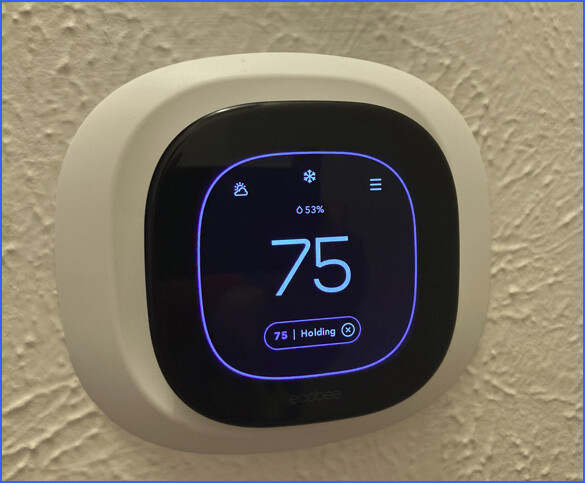
A few little surprises I wasn't aware of. I like the white back plate that it came with. It just looks a little more finished to me, rather than just having the thermostat itself directly attached to the wall.
Also, the proximity sensor is pretty neat and I didn't know it came with that either. The display changes as you walk past it from just providing basic information to sort of then anticipating that you might want to use it. I assume this also assists with the Ecobee knowing when someone is in or out of the home. I don't have those functions turned on though.
Finally, and this was a big surprise to me. The algorithms this Ecobee uses must be different than the legacy product I've been using for over a decade. The reason I say this is because I am certain stage 2 of my A/C would kick in more often in the past. With this latest Ecobee it is keeping my system in Stage 1 for everything except when the temperature outside reaches over 90 degrees. Then it is sort of forced to kick in Stage 2 to get the temperature down. But I'm super pleased to see Stage 1 getting so much use. Hopefully, that is easier on my compressor and it should result in lower electricity bills over time.
Ultimately, I'm pretty happy now and thanks again to those on the forum who helped me get here.
Your previous thermostat dates back to 2008-2009; that is 15-16 years ago. Things changed as more data became available from ecobee adopters. I was really happy to hear that you are generally happy with your decision to stick with ecobee, and the install price is very reasonable for removing the EIM and wiring in the new thernostat directly to the furnace control board.
@JPW and @dandanache
If you are interested in getting more out of your ecobee data along with methods of visualization, can I encourage you to check out Beestat. It is run by an HVAC expert/enthusiast, and supported by community donations. Here are some examples ....
The screenshot below has two panels. The upper panel shows the average outdoor temp for the past week in my house, along with the average indoor temperature. The linear bar indicates the comfort profile (home, away, sleep, etc). The vertical light and dark blue bars indicate whether the system was cooling in stage 1 or stage 2, along with the length of time it ran in that stage.
The lower panel shows the outdoor temp in white, along with individual temperatures from three sensors during the same time period as the upper panel. The blue/red/orange vertical bars indicate occupancy.
The upper panel in this screenshot indicates average outdoor temperature for the last 3 months (white line), along with the temperature range for each day (light grey fill). The light/dark blue vertical bars indicate the length of time spent in stage 1 vs stage 2 for each day.
The lower panel indicates system performance. The resist delta reveals temperature gain in the house (based on insulation, outdoor temperature, and things that generate heat within the house). For example, at 93F, my house would gain temperature at 1.5 degrees per hour. First stage cooling would decrease the temperature by 1.4 degrees per hour, while second stage cooling would decrease the temperature by 3.4 degrees per hour.
This screenshot indicates my houses' performance vs comparable houses, with a global comparison (there are very few people in Louisiana who use Beestat). The most useful metric here is runtime per degree day.
Finally, beestat also permits visualization of temperatures across the house using ecobee sensors. This actually shows up as a timescale video, and your house can be rotated. For example, in my screenshot, I have two sensors in upstairs bedrooms, and two sensors downstairs. The fifth temperature is from the thermostat itself. And that map is actually a pretty accurate depiction of the basic floor plan of my house.
The video linked to below shows a 24-hour temperature profile time-lapse based on data from the previous 7 days.
Thanks @aaiyar. I just connected Beestat. Really cool. I don't know if you are connected with Beestat or not, but let me just mention one thing I noticed. Understanding when my system is in stage 1 or 2 is helpful for me. The graphical representation shows it, but they are embedded on one line with 2 different shades of blue. At a glance it is difficult to tell just how much stage 2 was being used over the course of a day or two. I don't know if there is any way for me to customize this, but I just thought I would mention it.
Also, very interesting, and Beestat put up two flags about my system. That is, my differentials were set at .5 and Beestat is recommending they be at at least 1.0. I researched this a little bit and understand the logic. The greater differential will delay kicking in your system some in hopes that the overall use is less over time. Less wear and tear and less electricity costs. However, what about for 2 stage units? Is setting the differential to at least 1.0 always advantageous? With a 2 stage unit, my unit is staying in stage 1 for a longer period of time and may never engage stage 2. BUT increasing the differential to 1.0 could make Ecobee want to start engaging stage 2 more often, especially during those hot parts of the day where it is clear stage 1 isn't going to be enough. Does this make sense? Anyway, I just thought I would ask.
Thanks again for all your help.
Indeed. That's useful for all of us! Here's how you can see that in detail. If you place your cursor on any single cooling run, it will display the amount of time spent in each stage.
For example for the highlighted cooling run below, my system ran in Stage 1 for 20 minutes and Stage 2 for 31 minutes. The furnace blower (fan) was on for 51 minutes.
If you want to see the run time per day, you can do it from the analysis screen. In the example shown below, for September 3rd, my system ran in Stage 1 cooling for 3 hours and 4 mins. Stage 2 cooling was used for 5 hours and 51 minutes.
Only connected as a user. And I do support the project using Patreon.
Beestat has an online user community. Yours would be a good question to pose there.
